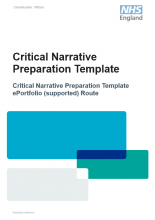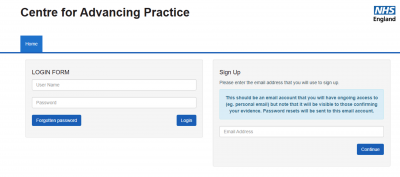ePortfolios must include a critical narrative to explain how the evidence provided demonstrates the capabilities outlined in the Multi-professional framework for advanced practice in England (the Framework).
The critical narrative should be between 3,500 and 5,000 words and is saved on the Centre’s portal in the ‘Application’ tab.
Purpose
The critical narrative is important because it:
- provides a reflective comment on the applicant’s education, knowledge, skills, and experience in preparing them for advanced level practice
- supports how the applicant works at the advance practice level
- guides the reader through the evidence base
- signposts each piece of evidence to the relevant pillar
- explains how the evidence shows that the applicant meets the capabilities within each pillar
- shows the applicant’s capacity for thinking critically about their practice at an advanced level, thus demonstrating the characteristics of writing at the Master’s level (Level 7)
Size and Structure
The critical narrative includes eight sections. Each section has a specified word range (see table below), bringing the total word count to between 3,500 and 5,000 words.
The table below outlines the sections of the critical narrative along with their corresponding word ranges:
| Section | Critical narrative: 3,500 words | Critical narrative: 5,000 words |
|---|---|---|
| Introduction | 300 | 430 |
| Clinical Practice Pillar | 750 | 1070 |
| Leadership and Management Pillar | 750 | 1070 |
| Education Pillar | 750 | 1070 |
| Research PiIllar | 750 | 1070 |
| Conclusion | 200 | 290 |
| References list | Not included in word count | Not included in word count |
| Evidence list | Not included in word count | Not included in word count |
Citations and references: the critical narrative, case studies, and reflective accounts must include citations and references.
Portal: applicants can write the critical narrative directly into the Portal, or copy and paste the text from another application, such as Microsoft Word.
The Portal saves work so applicants can return to their application before final submission. Once an application has been submitted it cannot be amended.
Referring to evidence: the critical narrative should include reference to the relevant pieces of evidence which are supporting the statement being made. The reference in the text should be in square brackets, for example, [CS1]; [FBS4]; [REFL8].
Evidence list: at the end of the critical narrative the applicant should link all the evidence cited in the text, using the ‘insert evidence reference’ function.
You can download a Word template of the critical narrative. Using the template is optional—some applicants may prefer to write directly in the portal instead.
Please note: the critical narrative in the portal is currently under development.
Plagiarism
If an ePortfolio, including the critical narrative and individual pieces of evidence, fails to recognise others’ contributions or explain how these have informed the content, the ePortfolio will not be progressed. This also applies to the use of generative artificial intelligence
Generative artificial intelligence (AI) can be used as a source of inspiration and help create ideas, or as a source of information, or to help with planning and management. It cannot be used to write the critical narrative or evidence for an applicant. The ePortfolio must be the applicant’s own work.
Non-urgent advice: Tips for writing at Master’s level for applicants
- Set out the narrative in a logical and coherent order
- Be precise: clear direct and to the point
- Be concise: short and clear, expressing what needs to be said without unnecessary words
- Use sign posting language to help the reader follow the argument
- Emphasise important points by giving them prime position in sentences or paragraphs
- Summarise any description and follow it with analysis (for example, why did it work or not work and what does it mean for meeting the capabilities)
- Make links between areas of knowledge
- Give specific and appropriate examples to illustrate the points made
- Comment/pass judgements, giving a reasoned opinion based on sound evidence
- Anticipate and account for any weakness in the narrative and demonstrate how these will be resolved rather than leave them for the reader to criticise
- Draw conclusions – does it show that the capability/pillar has been met
(Adapted from University of Edinburgh (2016) and University of Birmingham)
Non-urgent advice: Do not
- Muddle everything together
- Repeat or over-explain
- Be vague or waffle or include information which isn’t pertinent to demonstrating the point/how the capability has been met– i.e. outside scope of the critical narrative
- Use loaded or deliberately emotive language
- Assume the reader knows what happens in the role, how a person thinks or why are including certain information. Instead, an applicant should tell them explicitly why it is relevant and what it shows and why it is important
Resubmissions
If an applicant is required to provide additional evidence following the verification process, they should use the ‘resubmission box’ at the end of the critical narrative on the Portal to:
- add any new text/commentary
- list any new or revised evidence
- add links to the new or revised evidence
For further details see the Submission section of the Guidance.
Template

This template is designed to support applicants who prefer to draft their critical narrative in a Word document before copying and pasting it into the Centre’s portal.
Using this template is entirely optional. Some applicants may choose to write directly into the portal instead – both approaches are equally valid.
Please remember that all evidence must be uploaded to the portal and linked to the relevant capabilities. For full guidance, refer to the ePortfolio (Supported) Route Guidance.
Step by step portal guidance

The NHS Learning Hub hosts the Centre for Advancing Practice Portal guidance.
You will need an account at access. If you do not have an account, you can create one. When creating an account you will need to enter basic information on your role and place of work.
Centre for Advancing Practice Portal

The Centre for Advancing Practice Portal is a web-based tool that enables practitioners to record evidence of their experience, training and continuing professional development (CPD) for their entire career.